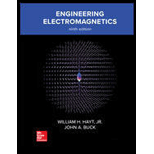
Concept explainers
A lossless transmission line having characteristic impedance
(a)
The input impedance to the line seen by the combination of voltage-source and resistor.
Answer to Problem 10.14P
Explanation of Solution
Given:
The characteristic impedance of lossless line is
Concept Used:
For quarter wavelength input impedance is
Calculation:
Although
Plugging value of load impedance and character impedance in above formula
Conclusion:
Hence, the input impedance to the line seen by the voltage-source resistor combination is
(b)
The power dissipated by the load.
Answer to Problem 10.14P
Explanation of Solution
Given:
Concept Used:
Power dissipated by the load is given by
Calculation:
Voltage across input impedance is given by
Plugging value of input
Hence power dissipated by the load is
Conclusion:
Hence,power dissipated by the load is 1.25W.
(c)
The voltage amplitude that appears across the load.
Answer to Problem 10.14P
Explanation of Solution
Given:
Length =
Concept Used:
Calculation:
In the line phasor voltage at any point is given by sum of forward and backward wave
Although
Assume load is located at z = 0 therefore
Hence l =
Thus
So
Using
Therefore, voltage at load is
Conclusion:
Hence voltage amplitude that appears across the load is
Want to see more full solutions like this?
Chapter 10 Solutions
Engineering Electromagnetics
- A lossless transmission line is 50 cm in length and operates at a frequency of 100 MHz. The line parameters are L = 0.2μH/m and C = 80 pF/m. The line is terminated by a load ZL = 50 + j20 Ω. Determine the: (a) reflection coefficient ; (b) SWR ; (c) the input impedance of the line. (d) What average power is delivered to ZL if the input voltage is 100 V?arrow_forwardA lossless transmission line has a Zo of 50 ohms and a line velocity of 2.4 x 10^8 m/s. If the operating frequency is 1 MHz. Determine the capacitance in pf.arrow_forwardQI/ A lossless coaxial cable of 170 mm long has the parameters L — 245 nWm andC — 200 pF/m. The operating frequency is f —I GHz and the line is terminated by ZL —100 Q, determine:A) The characteristic impedance.B) The input impedance at the input terminals of the line.C) The standing wave ratio on the line.arrow_forward
- Q1) A 70 cm long lossless transmission line with characteristics impedance of 50 Ω operating at 5Mhz is terminated with a load of ZL = (65+j80) Ω. If the velocity is 0.8 times the velocity of light, then calculate (a) The reflection co-efficient, also verify the value using the given smith chart.(b) Compute the input impedance using the transmission line input impedance equation.arrow_forwardQI/ A lossless coaxial cable of 170 mm long has the parameters L 245 nH/m and C 200 pF/m. The operating frequency is f 1GHz and the line is terminated by ZL 100 ome, determine: A) The characteristic impedance .B) The input impedance at the input terminals of the line. C) The standing wave ratio on the line.arrow_forward1. We have a two-wire overhead transmission line, powered by a constant voltage source of 700 V. The values for the inductance of the conductors are 2.348x10-3 H/km and the capacitance values are 6.325x10-9 F/km. Assuming an ideal (lossless) line and its length of 130 km, determine the speed at which it propagates. PLEASE MAKE IT DIGITAL BECAUSE HAND WRITING GETS UNDERSTANDINGarrow_forward
- A 50Ω lossless transmission line is terminated in a load (50+j100) Ω. Using a smith chart, determine the reflection coefficient.arrow_forwardA lossless transmission line has an inductance of 125 nH/m. Find the velocity factor for this line if the shunt capacitance is 200 nF/m.arrow_forwardA 2-meter, two-wire, lossless line with a characteristic impedance of 250 Ohms connects an antenna and a receiver. The dielectric constant of the line gives a velocity of 2.4x108m/s The antenna is modeled through its Thevenin network, in which a 500-microVolt 100-MHz source is in series with a 200-Ohm resistance. The receiver is modeled as a load impedance. 1. What is the wavelength on the line in meters? 2. What is the phase constant in rad/m? 3. What is the attenuation constant? 4. What is the electrical length of the line in degrees?arrow_forward
- At a frequency of 4 MHz a parallel wire transmission line has the following parameters: R-0,025 O/m. L-2 uH/m, G- 0, C5.56 pF/m. The line is 100 mcters long. terminated in a resistance of 300 Calculate the following i. Characteristic impedance of the line ii. Standing wave ratio iii. Voltage reflection coefficient of the load. iv. Recalculate the characteristic impcdance assuming the transmission line is lossless. V. Calculate the propagation constant of the linc B.arrow_forwardA cellular radio transmitter has a power output of 3 W at 800 MHz. It uses an antenna with a gain of 3 dBi. The receiver is 5 km away, with antenna gain of 12 dBi. Ignoring feedline losses and mismatch, calculate (a) the EIRP in dBW (b) the free space path loss, (c) the power delivered to the receiver in W and dBmarrow_forwardThe following characteristics have been measured on a lossy transmission line at 100 MHz: Zo = 50 + j0, α = 8 dB/m, and β = 1.5 rad/m. Determine R, L, G, and C for the line. Show the details of your work. Paste your scanned solution to the space provided below.arrow_forward
 Introductory Circuit Analysis (13th Edition)Electrical EngineeringISBN:9780133923605Author:Robert L. BoylestadPublisher:PEARSON
Introductory Circuit Analysis (13th Edition)Electrical EngineeringISBN:9780133923605Author:Robert L. BoylestadPublisher:PEARSON Delmar's Standard Textbook Of ElectricityElectrical EngineeringISBN:9781337900348Author:Stephen L. HermanPublisher:Cengage Learning
Delmar's Standard Textbook Of ElectricityElectrical EngineeringISBN:9781337900348Author:Stephen L. HermanPublisher:Cengage Learning Programmable Logic ControllersElectrical EngineeringISBN:9780073373843Author:Frank D. PetruzellaPublisher:McGraw-Hill Education
Programmable Logic ControllersElectrical EngineeringISBN:9780073373843Author:Frank D. PetruzellaPublisher:McGraw-Hill Education Fundamentals of Electric CircuitsElectrical EngineeringISBN:9780078028229Author:Charles K Alexander, Matthew SadikuPublisher:McGraw-Hill Education
Fundamentals of Electric CircuitsElectrical EngineeringISBN:9780078028229Author:Charles K Alexander, Matthew SadikuPublisher:McGraw-Hill Education Electric Circuits. (11th Edition)Electrical EngineeringISBN:9780134746968Author:James W. Nilsson, Susan RiedelPublisher:PEARSON
Electric Circuits. (11th Edition)Electrical EngineeringISBN:9780134746968Author:James W. Nilsson, Susan RiedelPublisher:PEARSON Engineering ElectromagneticsElectrical EngineeringISBN:9780078028151Author:Hayt, William H. (william Hart), Jr, BUCK, John A.Publisher:Mcgraw-hill Education,
Engineering ElectromagneticsElectrical EngineeringISBN:9780078028151Author:Hayt, William H. (william Hart), Jr, BUCK, John A.Publisher:Mcgraw-hill Education,





